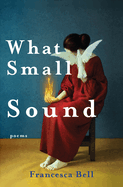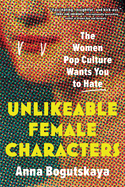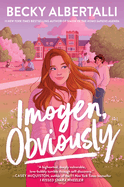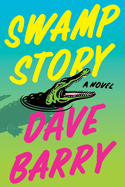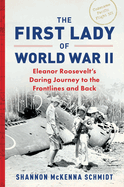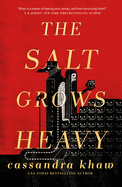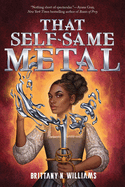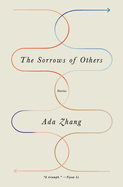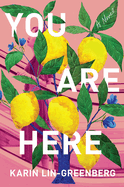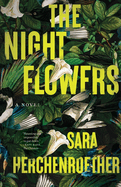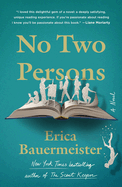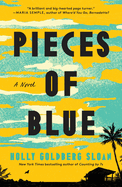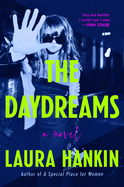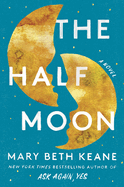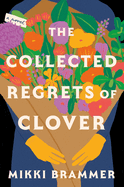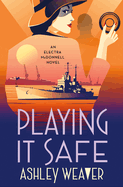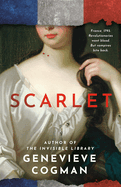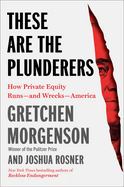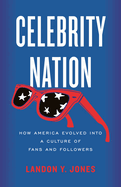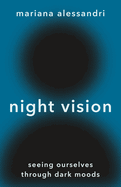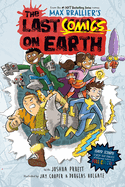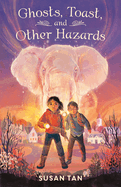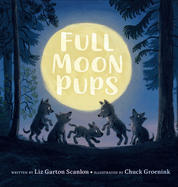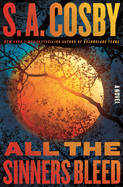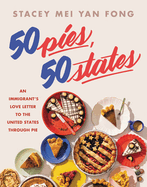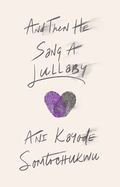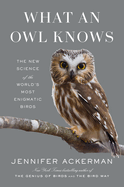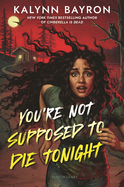Friday, May 12, 2023
This week, we review Becky Albertalli's sixth solo novel, Imogen, Obviously, "a sparkling romance and a moving account of a young woman's bisexual awakening"; along with two nonfiction works about strong women, First Lady of World War II by Shannon McKenna Schmidt, which "captivatingly captures" Eleanor Roosevelt's five-week tour of the South Pacific war zone in 1943; and Anna Bogutskaya's "nutrient-rich and delicious exploration" of film and TV's Unlikeable Female Characters. Plus so many more!
In The Writer's Life, Sara Herchenroether discusses the way she grappled with the word "survivor" and how that led to her first novel, The Night Flowers.
Swamp Story
by Dave Barry
Larger than life hijinks abound in Swamp Story, the zany thriller from Dave Barry (Best. State. Ever.; Lunatics, with Alan Zweibel). Jesse thought it made sense to move to the Everglades with her would-be reality television star boyfriend and their baby at the beginning of the Covid pandemic, but a couple of years later, neither the isolated cabin surrounded by snakes, nor the relationship, is looking so good anymore. A hidden cache of gold bars she discovers could give her a chance to start over without throwing herself on her parents' mercy. But she'll need to claim it first, without any of the ruthless men who know she found it tracking her to the rest.
Meanwhile, Phil, an unemployed reporter who spends his days drinking three-for-the-price-of-one Moscow mules, goes viral in a video, in which he is struck with a golf club while wearing a Dora the Explorer costume head. This gives Ken at Bortle Brothers Bait and Beer an idea for how to return his failing store to its former tourist-trap glory. One TikTok craze later, and they can't keep "Everglades Melon Monster" shirts on the shelves; tourists are flooding the area; and giant snakes, local newscasters, and the secretary of the interior are all swept up in a hilarious caper that could only happen in Florida. Fans of Barry and Carl Hiaasen will be on the edge of their seats--except when they're rolling on the floor. --Kristen Allen-Vogel, information services librarian at Dayton Metro Library
Discover: Dave Barry's wacky crime caper celebrates the weirdest, most wonderful vision of the Sunshine State.
The Sorrows of Others
by Ada Zhang
The Sorrows of Others, Ada Zhang's first book, is a startling collection of 10 luminous short stories about memory, alienation, and homecomings. In "The Subject," an art student finds an interesting--and unsettling--interview subject in her grandmother, who speaks about her memories from her time in Xi'an. "Sister Machinery" tells the story of the youngest in a trio of sisters, who grapples with her feelings of grief and isolation within her own family after her middle sister dies in a tragic accident. A long-time widower in the titular "The Sorrows of Others" agrees to marry a woman his daughter finds and is surprised to discover the woman's unfamiliarity to be a kind of comfort.
Zhang's crisp writing delights in physical clarity even as it plumbs emotional depths. The young woman undergoing a complex coming-of-age in "Propriety" reacts to her mother's voice by seeing details: "the water rings on the coffee table, a California-shaped stain on the pillow where my phone had been sitting.... An orange paper lantern hung from the ceiling in the kitchen, the Chinese symbol for love painted on it." As is true for the first-person narrator of this story, these small details will keep Zhang's readers focused, even as the emotional heft of these stories threatens to untether them. It is this same precision that lets stories like "One Day"--about being an outsider, finding unexpected empathy, and losing a father--to click into place in a deceptively short set of four pages. Like a flash, these stories are a burst of light, ending almost as soon as they start, but they leave a strong afterglow. --Alice Martin, freelance writer and editor
Discover: An empathetic and graceful literary debut by Ada Zhang, The Sorrows of Others is a story collection that communicates emotional and political weight through the profoundly quotidian.
The Secret Book of Flora Lea
by Patti Callahan Henry
In The Secret Book of Flora Lea, a tribute to the power of storytelling from Patti Callahan Henry (The Favorite Daughter; The Bookshop at Water's End; The Stories We Tell), a whimsical fantasy spun to comfort a frightened child displaced by World War II lies at the heart of a decades-old mystery. Henry's 17th novel captures the magic of childhood as well as the brutality of wartime, then moves the story forward 20 years, where the victims still grapple with trauma.
Hazel, 14, and her five-year-old sister, Flora, are evacuees from London. They move to the safety of rural Oxfordshire during the British government's 1939 "Operation Pied Piper." Hazel comforts her sister with elaborate stories of "Whisperwood and the River of Stars," a secret fantasyland they share. The bucolic countryside invites carefree play--until one day Flora vanishes, presumed drowned in a rain-swollen Thames. Hazel, tormented by grief and guilt that she'd failed Flora, clings to hope that she's alive. Working in a rare book shop in 1960, Hazel is stunned to discover Whisperwood, a book by an American author. She decides this is a clue: "This book will lead me to Flora."
In alternating chapters, set in 1939-40 and 1960, the mystery of Flora's disappearance and the tenacity of Hazel's quest to find her unfold in suspenseful layers. Sympathetic characters--the American author, a London journalist researching lost "Pied Piper" children, and the people of Oxfordshire--reveal critical secrets, including a surprising twist. Henry's lyrical prose imparts an optimism about how, in spite of the past and its residual pain, "We make art from our broken hearts." --Cheryl McKeon, Book House of Stuyvesant Plaza, Albany, N.Y.
Discover: In a propulsive and lyrical novel, the discovery of a book with a secret fairy tale she once shared with her long-missing sister prompts a London bookseller's quest.
You Are Here
by Karin Lin-Greenberg
Karin Lin-Greenberg (Vanished) is an award-winning short story writer, a skill that shines through in her debut novel, You Are Here. In it, she explores the many moments that make up a human life--and how the intersection of moments across many lives shapes new possibilities in unexpected ways. Jackson spends the hours after elementary school hanging out with his mother, Tina, at the mall salon where she works. He sometimes visits Maria, who dons a chicken costume each day after high school to serve sad food at the food court. Kevin manages the bookstore across from the salon, a job that offers a brief respite from an otherwise cramped life spent with his wife and rambunctious twin children in the tiny house he's built in his mother-in-law's yard. Ro, the elderly widow who lives next to the tiny house, visits the mall to get out of her house and interact with other people, even if those interactions often bring out her cruelty and prejudice.
At first glance, it's hard to see what these characters could have in common besides their frequenting of a soon-to-be-shuttered mall, but Lin-Greenberg weaves together their individual stories with skill and nuance. As their paths cross--both in and out of the mall itself--their lives become entangled in unexpected ways, until a shocking act of violence in the food court leaves them reeling as individuals and a community.
The small details of each character's experience provide a kaleidoscopic portrayal in this heartfelt exploration of what makes up a life: secret hopes and dreams, human interactions, moments of kindness and care. --Kerry McHugh, freelance writer
Discover: You Are Here is a heartfelt exploration of the many moments that make up a life--and how the intersection of moments across many lives shapes new possibilities in unexpected ways.
The Night Flowers
by Sara Herchenroether
The gruesome discovery of three bodies deep inside New Mexico's majestic Gila National Forest in the '80s sets the gripping premise for Sara Herchenroether's unforgettable debut, The Night Flowers. Seasoned with supernatural suspense, including a killer who stalks the ghosts of his dead victims, The Night Flowers is an entertaining crime thriller enhanced with the engaging personal dramas of the two women investigating the triple homicide.
Thirty years have passed since the bodies were found, and the victims, a woman and two girls, were never identified. Detective Sergeant Jean Martinez, a tough-talking veteran of the Sierra County police force, reopens the cold case on this solemn anniversary, insisting that the victims deserve the dignity of being known by their names.
Meanwhile, in Connecticut, a young librarian, Laura MacDonald, is transfixed by the case, eager to deploy her amateur genealogy skills to identify the victims. Recovering from a bilateral mastectomy after treatment for breast cancer, she flies to New Mexico, hoping to put the medical ordeal behind her.
Narrated by Laura, Jean, and the murdered woman herself, The Night Flowers features bewitching descriptions of eerie pine-scented forests animated by birdsong. As Laura and Jean's increasingly dangerous investigation takes them deeper into the killer's past, the victims claim space to share their own harrowing story.
Herchenroether, a true-crime aficionado, is a skilled storyteller. Laura's agonizing wait to see if her cancer returns, and Jean's refusal to follow her husband into retirement are real-life dilemmas underpinning their blossoming friendship as they unearth the complex layers of a horrific crime. --Shahina Piyarali, reviewer
Discover: Set in New Mexico, this ghostly debut thriller explores the blossoming friendship between a police detective and a young librarian recovering from breast cancer.
No Two Persons
by Erica Bauermeister
No Two Persons by Erica Bauermeister (House Lessons: Renovating a Life; The Scent Keeper; The Lost Art of Mixing), a poignant homage to the magic of books and storytelling, links unrelated characters' stories with a common thread: a debut novel entitled Theo. Alice is a young writer, hesitant to release her deeply personal novel, Theo, into the world. "We're all caretakers of the stories, Alice," her mentor tells her. "Writers are just the lucky ones that get to know them first." No Two Persons follows Theo over nine years, into the lives touched by the story, often in surprising ways.
Among the readers are a literary agent's assistant, rocking her newborn while poring over submissions; a bright high school student, concealing her homelessness; a grieving widower, isolating in a ghost town; and a former film star, honing his talent for performing audiobooks. Bauermeister tells the stories of these distinctive, sympathetic characters in individual chapters, each revealing more about Theo. Reading No Two Persons can foster melancholy for the protagonists when their chapters end, but clues suggest that as they "wander," as Theo does, they'll find happiness. One character wonders, "Can we never truly connect?" and concludes: "All that matters is that we try." Indeed, serendipitous, heartwarming coincidences eventually do connect some of these thoughtful characters. No Two Persons is a meticulously crafted novel sure to transport readers, as books do, to "places you didn't know you needed to go." --Cheryl McKeon, Book House of Stuyvesant Plaza, Albany, N.Y.
Discover: This poignant homage to books and storytelling follows a powerful debut novel into the lives of its readers, leading each of them to self-discovery.
Pieces of Blue
by Holly Goldberg Sloan
In screenwriter and YA novelist Holly Goldberg Sloan's charming first novel for adult readers, Pieces of Blue, a family moves to Hawai'i for a fresh start following a devastating tragedy. Lindsey Hill doesn't know what to do after her husband, Paul, drowns while surfing, leaving her with the scraps of a failed company, piles of debt, and three children to raise. When the life insurance payment arrives, Lindsey decides, perhaps recklessly, to buy a struggling but picturesque motel in Hawai'i. Her children--Olivia, Carlos, and Sena--adjust to their new lives and, respectively, develop a crush, foster a new persona, and protect the small things they can. Meanwhile, Lindsey finds herself falling for the handsome Chris, who inexplicably offers to be their handyman at no charge. But Chris may have his own investment in the Hill family that Lindsey isn't aware of, while off the coast a storm is brewing.
The big-hearted nature of Sloan's previous novels can also be found in this warm and welcoming story of a family's emotional and often humorous recovery. Sloan (Short; Appleblossom the Possum; Counting by 7s) skillfully balances the perspectives of Lindsey with each of her three children, imbuing the characters with the kind of personality details and gentle eccentricities that have made her family dramas shine. But undergirding these tender characters and their individual and collective turmoil is a winking sense of humor that reassures readers that things for the Hill family will work out--despite some unexpected (and they are unexpected) twists along the way. --Alice Martin, freelance writer and editor
Discover: A feel-good family portrait, Piece of Blue is a novel that packs an emotional punch as it delves into its characters' many complexities.
The Daydreams
by Laura Hankin
Laura Hankin (Happy & You Know It; A Special Place for Women) creates a captivating and nostalgic piece of fictional 2000s pop culture in The Daydreams. Each of the former cast members of the hit teen show The Daydreams went their separate ways after the show ended abruptly during the disastrous season-two live finale. Kat turned to law; Liana became an influencer and trophy wife; Noah still works in Hollywood; and Summer is the media's stereotypical teen star turned "hot mess." They had all put the whirlwind success of their career-starting (or -ending) role on The Daydreams in their rearview mirror 13 years ago--and then Noah admits in an interview that he'd be open to a reunion.
They each agree, with their respective motives, to the Daydreams reunion special. Kat's experience returning to the set reveals her emotions and secrets from more than a decade ago--and maybe even the reason for the show's demise. A journal given to Summer to help her cope with her father's death before season two seems to have the answers. Looking for redemption and even revenge, the actors find new endings for their fictional and real-life narratives.
The Daydreams is a creative dramatization of the ways in which the immense pressures of the television industry can corrupt teen stars, and gives readers an intimate look at the complex realities of a 2000s teen show. The cast's friendships, rivalries, and romances are exposed and exploited through their return to their old characters, on stage together for one last live performance. --Clara Newton, freelance reviewer
Discover: The Daydreams is a riveting and nostalgic drama that follows teen stars who gather for a reunion show, resurfacing the secrets that tore them apart.
The Half Moon
by Mary Beth Keane
"How'd we get here, Jess?" Malcolm Gephardt asks his wife at one point in The Half Moon. The story of how Malcom and Jess arrived "here"--separated and unhappy in their mutual hometown of Gillam, N.Y.--and how they're proceeding to cope is told nimbly and well in Mary Beth Keane's marriage-in-crisis novel.
Malcolm is worried about his struggling bar, the Half Moon. He's also worried about his marriage, such as it is: he and Jess have been living apart for four months, having succumbed to the strains of financial burdens, years' worth of failed fertility attempts, and Jess's realization that Malcolm has been keeping something from her. She's been staying with a friend in Manhattan, but early on in the novel Malcolm learns that Jess has been spotted in Gillam with a fairly recent transplant: a divorced dad who is, like her, a lawyer.
Keane (Fever; Ask Again, Yes) dips into the minds of both Malcolm and Jess, who, while on the verge of leaving him, was tempted to point out that, as she saw it, "it was the first time in a long time that he'd paid attention to a single thing she did." The Half Moon is more capacious than the customary strained-relationship novel, accommodating unguarded considerations of how work, class, and ambition bear on a partnership. Keane traffics in naturalism, meting out carefully composed scenes bustling with Gillam folks, the central two of whom would have likely made a mess of their marriage anywhere. --Nell Beram, author and freelance writer
Discover: This capacious marriage-in-crisis novel, centered on a bar owner and a lawyer, accommodates unguarded considerations of how work, class, and ambition bear on a partnership.
The Collected Regrets of Clover
by Mikki Brammer
The Collected Regrets of Clover is journalist Mikki Brammer's first novel, a heartfelt and poignant story focusing on a death doula, and all she learns in her work with death and dying--and, in the process, about life and living.
Clover Brooks was just five years old when she first saw a person die (her kindergarten teacher), and has witnessed 96 more deaths since then in her work as a death doula. "A birth doula helps usher someone into life, and a death doula helps usher them peacefully out of it," Clover explains patiently to a new neighbor. It's work she's proud of and honored to do, though she realizes that her proximity to--and comfort with--death marks her as "out of step with the rest of the world." And perhaps she is a bit odd, but she's mostly okay with that--even if she's also a bit lonely, and unsure of how to go about becoming less so: "It wasn't that I was opposed to the idea of friendship, it's just that if you don't get close to anyone, you can't lose them."
That's all thrown into chaos when Clover's latest client--a wealthy old woman with a charming smile and a sense of adventure--inadvertently sets Clover on a scavenger hunt through old photos and letters in search of a long-lost lover. Though tinged with the sadness, The Collected Regrets of Clover is ultimately a beautiful story of belonging, connection, and what it really means to live life to its fullest. --Kerry McHugh, freelance reviewer
Discover: A death doula learns to be as comfortable with life as with death in a heartfelt novel about grief, love, and belonging.
Mystery & Thriller
Playing It Safe
by Ashley Weaver
In Playing It Safe, the third Electra McDonnell mystery, Ashley Weaver sends her quick-witted heroine to Sunderland for an adventure filled with espionage, bird-watching, and some good old-fashioned safecracking. Weaver (The Key to Deceit; A Peculiar Combination; A Deception at Thornecrest) takes Ellie out of her usual London context to test her mettle as a spy, which also adds a few layers to her already complicated relationship with Major Ramsey.
Weaver renders her 1940s setting in crisp historical detail; Ellie narrates, and she makes it her business to notice things. Ellie narrowly escapes injury upon her arrival in Sunderland and witnesses a suspicious death, prompting her to start investigating on her own before the major even arrives. The two have a charged, highly entertaining dynamic marked by respect for each other's intelligence; clashing investigative methods; and quite a bit of romantic tension. As Ellie wrestles with her inconvenient feelings, she also befriends a group of locals around her own age, any one of whom may be hiding something.
Weaver's plot zips along, taking in a wealthy eccentric with a penchant for birds and rare books, as well as the local chemist's shop, a printing press, and a possible forgery ring. Ellie finds herself in dire circumstances more than once, but her quick wit, lock-picking skills, and luck get her out of a few tight spots. A cliffhanger ending involving a family secret will leave readers eagerly awaiting Ellie's next adventure. --Katie Noah Gibson, blogger at Cakes, Tea and Dreams
Discover: Ashley Weaver's third Electra McDonnell mystery engages readers with a safecracking heroine who heads to the north of England for a bit of espionage.
Science Fiction & Fantasy
The Salt Grows Heavy
by Cassandra Khaw
Cassandra Khaw (A Song for Quiet; Hammers on Bone) vivisects myths and stitches them into each other in The Salt Grows Heavy, a gorgeous and gory horror fantasy novella that thrums with the pull of the deep. A mermaid princess whose newborn daughters have devoured a kingdom leaves her offspring to feast on the subjects of their father, a prince who stole her from the sea and cut out her tongue. Accompanying her into the world is a mild-mannered plague doctor, an androgynous being stitched together from many bodies. Out in the wild, the pair meet a collection of savage children who make games of murdering each other. The children lead them to their "saints," the same three mad surgeons who created the plague doctor. When the plague doctor decides they cannot leave the children to serve as body-part farms for the surgeons' experiments in immortality, the mermaid joins her companion in a cruel and deadly cat-and-mouse game that will take them into the heart of their own darkness.
"All of my kind are just souls with a cloak of skin and scales, barely tethered to the act of living," the mermaid says, but her narrator's voice is fresh and vital, the depth of her growing attachment to the plague doctor palpable. The sweetness of their bond provides a bright spot in a progressively darker and bloodier story made vivid by Khaw's poetic prose. Fantasy horror fans should love this fairy-tale gem. --Jaclyn Fulwood, blogger at Infinite Reads
Discover: A mermaid and a plague doctor face off against three mad doctors in this bloody, fairy tale-inspired fantasy horror novella.
Scarlet
by Genevieve Cogman
Some of the French aristocrats fleeing the revolution aren't just metaphorical bloodsuckers in Scarlet by Genevieve Cogman (The Untold Story; The Dark Archive; The Invisible Library), but that "demmed" elusive Pimpernel and his league are out to rescue all they can just the same. Nellie Dalton hopes for more than her position as a housemaid to a vampire baroness. She has enough seniority that she's no longer required to bleed into a cup for her mistress, but she hopes one day to be a lady's maid or even an embroiderer in a shop in London. Then the baroness calls her in specifically to serve refreshments for two of her guests, and show them that she bears an uncanny resemblance to someone they all know from France. Soon she is whisked away to Blakeney Manor to learn how to play her role in the most ambitious plan yet from the League of the Scarlet Pimpernel.
Cogman perfectly captures the voice of the original Scarlet Pimpernel in the novel of the same name by Baroness Orczy, and is clearly well-versed in the entire series. Fans will be thrilled to find themselves half a step ahead, with just the right subtle reference cluing them in on a character's identity before it's revealed. Still, there is plenty of adventure for those with no previous knowledge--all of it just melodramatic enough. If the ramifications of the Scarlet Pimpernel being friendly with literal vampires are to be explored more thoroughly in future installments, the result could be an even more perfect paranormal pastiche. --Kristen Allen-Vogel, information services librarian at Dayton Metro Library
Discover: Seek this French Revolution vampire adventure here. Seek it there. Seek it everywhere.
Graphic Books
Impossible People: A Completely Average Recovery Story
by Julia Wertz
Cartoonist Julia Wertz (Drinking at the Movies) makes comics that defy expectations, and with Impossible People, she offers a graphic memoir that tackles addiction, but with none of the expected dramatic highs and lows. The book opens boldly with a single panel depicting Wertz stranded after crashing a rental car in Puerto Rico and the simple phrase: "What the fuck." As the narrative flashes back to four years earlier, readers might assume they know what's going on--a drunk Wertz crashes her car, and realizes she has a problem. But in the comic, as in life, it's not that simple.
Wertz perfectly captures the oscillation between wanting to quit drinking and being unable to, a dance familiar to many who struggle with addiction. She knows she has a problem, but she's not as bad as her brother, who regularly overdoses before seeking treatment and getting sober. By contrast, she has a quiet and dull life, even if it is one dominated by a need to drink to the point of blacking out every night.
Despite these difficult elements, Impossible People is decidedly funny. The book is also uncommonly beautiful. Wertz proved her skill at architectural drawing in Tenements, Towers & Trash, and here she uses meticulously observed and finely crafted city scenes as a backdrop to her story. The contrast between the deceptively simple panels focused on dialogue or relationships and the heavily detailed storefronts and streetscapes is incredibly effective, helping readers to see, as Wertz does, the beauty of "little scenes of everyday life." --Sara Beth West, freelance reviewer and librarian
Discover: Impossible People's humor and honesty will appeal to readers universally, but for those in addiction and recovery circles, it is an act of generosity that might actually save lives.
History
The First Lady of World War II: Eleanor Roosevelt's Daring Journey to the Frontlines and Back
by Shannon McKenna Schmidt
In 1943, during the grueling war with Japan, First Lady Eleanor Roosevelt went on a five-week tour of the South Pacific that included Guadalcanal and other battle sites. Shannon McKenna Schmidt (Writers Between the Covers, with Joni Rendon) fully and captivatingly depicts the journey in The First Lady of World War II. Eleanor had already controversially broken the tradition of the quiet, demure First Lady in the first decade of Franklin Roosevelt's presidency by publicly supporting the New Deal, the war effort, and the struggles of Black people, poor people, and women. Now she was traveling by herself in the war theater.
In the beginning, it was a top-secret trip that was frowned upon by many military leaders. But Eleanor persisted, wanting most of all to show "our boys" that they were supported by the people back home. She made a point of visiting as many individual soldiers as she could, from the highest to the lowest ranks, particularly the wounded in hospital wards. She lifted morale with her compassion and energy and repeatedly won over those who disagreed politically with her or didn't think she should make such a trip. Australia and New Zealand, which sometimes felt neglected by their allies in the Northern Hemisphere, welcomed her like royalty. Although the trip was exhausting--she lost 30 pounds in five weeks--it was considered more than worth the many risks.
Relying on such sources as contemporary news reports and commentary, letters, reminiscences by soldiers, Eleanor's diary, and her regular newspaper column, "My Day," McKenna Schmidt puts the trip in context and provides a lively account of an often overlooked, inspiring journey. --John Mutter, editor-in-chief, Shelf Awareness
Discover: Shannon McKenna Schmidt provides a full, captivating account of the unusual trip by First Lady Eleanor Roosevelt to the front lines in the South Pacific during World War II.
Business & Economics
These Are the Plunderers: How Private Equity Runs--And Wrecks--America
by Gretchen Morgenson and Joshua Rosner
Those who don't closely follow the world of business and investing may be only dimly aware of the phenomenon known as private equity. By the time readers have finished Pulitzer Prize-winning investigative reporter Gretchen Morgenson and banking and financial consultant Joshua Rosner's thorough, unsparing These Are the Plunderers, their eyes will be opened wide to the machinations of this small group of "modern-age robber barons" whose relentless practice of a "rapacious form of capitalism" allows them to amass unimaginable wealth at enormous cost to American businesses, workers, and taxpayers.
In their disturbing story, Morgenson and Rosner (Reckless Endangerment) devote considerable attention to the activities of Leon Black and his investment firm Apollo Global Management. Apollo rose out of the ashes of Drexel Burnham Lambert, a Wall Street company that became notorious in the 1980s for peddling so-called junk bonds to finance corporate buyouts, and that collapsed amid charges of criminal fraud. Executive Life Insurance Company had been a Drexel client, and in a painstaking account, the authors describe how Black took advantage of that connection to engineer, with the aid of California's insurance commissioner, a takeover of the troubled insurer. The result? Massive profits to Black and Apollo, and disastrous losses of some $3 billion to Executive Life's policyholders.
These Are the Plunderers presents many more of these troubling case studies. Men like Leon Black don't build or create anything. As Morgenson and Rosner so lucidly explain, these "modern privateers" simply act as dealers reshuffling marked cards in the deck of American capitalism. In the high stakes game they're playing, it's a deck that's stacked against the rest of us. --Harvey Freedenberg, freelance reviewer
Discover: In this exposé, Gretchen Morgenson and Joshua Rosner reveal how private equity firms reap massive profits at the expense of most other actors in the American economy.
Social Science
Unlikeable Female Characters: The Women Pop Culture Wants You to Hate
by Anna Bogutskaya
Good pop-culture writing is the literary equivalent of a nutritious Twinkie. Anna Bogutskaya's Unlikeable Female Characters: The Women Pop Culture Wants You to Hate is a nutrient-rich and delicious exploration of film and television's so-called unlikeable women. It's also a caution that prizing on-screen female likeability ("code for marketability") while applauding male characters who misbehave caters to a pernicious double standard.
Following a brief history of unlikeable female characters in movies and on TV, Bogutskaya devotes chapters to each of nine such personae: the Bitch, the Mean Girl, the Angry Woman, the Slut, the Crazy Woman, the Psycho, the Trainwreck, the Shrew, and the Weirdo. Bogutskaya dissects relevant flash points from the screen while she's defining her terms: "Trainwrecks are hungry characters. And female hunger, whatever shape it takes, has always been scrutinized, chastised, and punished." Among the films and series she uses as case studies are Thelma & Louise and Waiting to Exhale (re: the Angry Woman); Mae West's movies and Sex and the City (the Slut); and Gone Girl and Killing Eve (the Psycho).
Unlikeable Female Characters is such dishy fun that it's almost possible to forget the problem that brought the book into being in the first place. As Bogutskaya says of the straitjacket of female likeability, "Once characters are allowed to let go of the pressure to be nice, to conform to an impossible, made-up ideal of how a woman should look and behave, they are allowed to be messy, complicated, angry, vulnerable, and human." --Nell Beram, author and freelance writer
Discover: Anna Bogutskaya offers a nutrient-rich and delicious exploration of film and television's so-called unlikeable women.
Celebrity Nation: How America Evolved into a Culture of Fans and Followers
by Landon Y. Jones
As a member of the staff of People magazine at its creation in 1974, Landon Y. Jones speaks with considerable authority on the subject of American celebrity culture. Jones turns a cold eye in Celebrity Nation on the "vast profit-generating enterprise we can think of as the celebrity-industrial complex" and how it has erased the line between those worthy of widespread recognition and the merely (and often undeservedly) famous.
In this slim primer, Jones (William Clark and the Shaping of the West) seeks the roots of American celebrity worship in 19th-century characters like Calamity Jane and draws a thread through her attention-seeking stunts to modern-day counterparts like Paris Hilton and Kim Kardashian. He's less assured when it comes to cause and effect, but with the rise of reality television and the ubiquity of social media, he's willing to lay at least some of the blame for the decline of citizens' civic engagement at the feet of celebrity obsession.
Jones seasons his more objective commentary with revealing memoir-like snippets, recalling his encounters with celebrities like Elizabeth Taylor, Princess Diana, and his childhood idol, St. Louis baseball star Stan Musial, each of them an example of how society has moved from a "natural aristocracy of talent and charisma that establishes the value of fame" to an "aristocracy of numbers--the calculus of followers, likes, friends, and downloads." Others have--and will--explore this topic in more depth, but Jones's clear-eyed, often rueful take on the phenomenon is an excellent starting point. --Harvey Freedenberg, freelance reviewer
Discover: Former People magazine managing editor Landon Y. Jones decries the malignant effect of mindless celebrity worship on American society.
Psychology & Self-Help
Night Vision: Seeing Ourselves Through Dark Moods
by Mariana Alessandri
Debut author Mariana Alessandri makes a compelling, philosophically sound case for finding "dignity" and strength in the discomforting emotions that are a natural part of the human condition in Night Vision: Seeing Ourselves Through Dark Moods. Instead of silencing, stifling, or feeling embarrassed by our anger, sadness, grief, depression, and anxiety, Alessandri and her favorite existentialist philosophers, including Gloria Anzaldúa and Miguel de Unamuno, encourage readers to cultivate greater self-knowledge and forge deeper connections with loved ones through the expression of our dark moods. Alessandri, an associate professor of philosophy at the University of Texas Rio Grande Valley, rebuts ancient Western philosophical theories that declare that light, emotional and otherwise, is "holier than dark" and that darkness is to be feared. Under the "fluorescent lights of psychiatry," depression and anxiety are classified as mental illnesses or disorders, while the self-help industry, in trying to sell us a brighter future, makes us feel ashamed that we are not happier.
What if, proposes the author, instead of viewing anger as a character flaw that makes us ugly, we interrogate the source of the emotion, and let it work productively for us? Alessandri follows the examples of Audre Lorde and María Lugones in successfully deploying the energy behind her own pandemic lockdown anger towards solutions for juggling work and self-care while homeschooling her children. Through insightful observations of temperaments at the dark end of the emotional spectrum, Night Vision reminds readers that our humanity is only truly visible in the dark and that the darkness is where we emotionally grow. --Shahina Piyarali, reviewer
Discover: Following the example of her favorite existentialist philosophers, a writer and philosophy professor encourages readers to embrace the dark side of their emotional spectrum.
Poetry
What Small Sound
by Francesca Bell
Francesca Bell (Bright Stain) writes poems that chime like the bell of her own name: bright but resonant, sharp but still familiar, lush and likely to echo long after its initial strike. What Small Sound is Bell's second collection, and it brings together a haunting yet beautiful set of poems centered on the losses--or potential for them--that encircle her: the loss of her hearing; the mental health concerns that threaten the loss of her daughter; and the loss, too, of a general sense of safety, wrought by Covid-19, parenting, and aging. Despite these losses, and the fear and heaviness that accompany them, Bell writes poems that insist pain is only one part of every story.
The opening poem, "Jubilations," strikes fast and hard with "Every two minutes, an American woman is raped" and follows with references to mass shooters and the tensions of wealth and destruction. It concludes, however, with an imagined prayer: "Thank You for this world of green grass and suffering." A similar tangle of emotions accompanies many of the poems, most poignantly in "Becoming," a short poem that begins, "Once, I was a whole person." After noting her transformation "through trauma," the final lines make clear the nature of that change: "After, the doctor placed the baby/ among my body's wreckage./ I learned to call this love." In so many ways, Bell chronicles the inevitability of suffering in a world full of love, and readers will appreciate her unflinching gaze and radiant images. --Sara Beth West, freelance reviewer and librarian
Discover: In What Small Sound, poet Francesca Bell chronicles the inevitability of suffering in a world full of love, and readers will appreciate her unflinching gaze and radiant images.
Children's & Young Adult
Imogen, Obviously
by Becky Albertalli
Becky Albertalli (Simon vs. the Homo Sapiens Agenda; Kate in Waiting) is known for her warm and insightful stories about queer teens finding self-acceptance and first love. Her sixth solo novel, Imogen, Obviously, is both a sparkling romance and a moving account of a young woman's very contemporary bisexual awakening.
Eighteen-year-old Imogen Scott is "hopelessly, blindingly, obviously straight." She tries her best to be a "capital-A Ally" to her friends and queer younger sister but is nervous about visiting her "Brazilian pansexual" friend, Lili, at college. Lili further complicates matters by revealing that she told her new, cool queer friends that she and Imogen used to date. Although Imogen is nervous, she agrees to pretend to be Lili's bisexual ex for the weekend. Then Imogen meets dark-haired lesbian Tessa, who has "Winona Ryder eyes" and "Clea DuVall freckles," and feels an instant attraction. A single weekend makes Imogen question if her sexuality might not be so obvious after all.
Imogen, Obviously portrays the Internet-era nature of discrimination against bisexual women through the eyes of one such young woman. Albertalli empathetically considers the nuance of queer identity and the harm caused by gatekeeping who is allowed to identify as LGBTQ+. As Imogen says, "no two people seem to do queerness in the same way." Imogen, Obviously is a deeply personal novel about queerness in all its colorful complexity and a rallying cry to "hold space for variation" in the LGBTQ+ community. --Alanna Felton, freelance reviewer
Discover: A teenage girl falls in love during a weekend college visit and begins to question the assumptions she holds about her sexuality in this stirring YA contemporary novel.
That Self-Same Metal
by Brittany N. Williams
Secret magical abilities, rebellious Fae, and Shakespearean England commingle in this imaginative YA novel featuring a strong, swashbuckling Black heroine fighting to keep the human world safe from murderous immortals.
Sixteen-year-old Joan Sands is the sword handler for Shakespeare's acting company, based in London and patronized by King James. Her future holds few options beyond marrying her father's inept apprentice and assisting in his shop. But Joan and her godfather are the "only living children of Ogun," the Orisha of iron, who gifted Joan her special talent with metal. When Baba Ben is imprisoned, he cannot renew the London peace pact Ogun helped mediate between His Majesty and the Fae. The responsibility falls to Joan. Worse, after she saves the son of the powerful Earl of Salisbury, he insists she kill Auberon, king of the Fae. As a Black woman, Joan has little power to refuse, but she hasn't been trained for any of this. Luckily, she can count on twin brother James and Shakespeare's entire company, both human and Fae. A couple of romantic crushes along the way ensure that Joan is one busy, magic-blessed teen.
That Self-Same Metal is a richly woven fantasy that takes place in an alternate 1605 London populated with bloodthirsty Fae, versions of which Shakespeare has "watered-down" to use as characters in his plays. Williams's leading lady, Joan, struggles convincingly to find her place amid the unfair gender and racial norms of her day. This story has all the elements necessary for a clever, entertaining, thoughtful read. --Lynn Becker, reviewer, blogger, and children's book author
Discover: A strong, magic-blessed Black heroine must save Shakespearean London from hordes of rogue Fae in this imaginative, swashbuckling fantasy.
The Last Comics on Earth
by Max Brallier and Joshua Pruett, illus. by Jay Cooper and Douglas Holgate
The characters from The Last Kids on Earth become crime-fighting superheroes in The Last Comics on Earth, the funny, adventurous first graphic novel from the team behind the Last Kids on Earth series.
When Jack, Dirk, June, and Quint realize the last comic of their favorite superhero, Z-Man, ended on a literal cliffhanger, they take it upon themselves to finish the story. In their own comic, the Kids grant themselves unique abilities and starring superhero roles--Boy Lightning, The Savage Aloner, Moonstar the Quasar Warrior, and Doc Baker respectively--and they create a brand-new villain: Muto the Unsympathetic. The four, along with Meepu, a dog/teddy bear/mech suit, work together (and separately) to foil Muto's plan to take over the city of Apocalyptia.
The Last Comics on Earth is two graphic novels in one. The first shows Jack, Dirk, June, and Quint plotting out and writing the Z-Man comic; the second is the Z-Man comic itself, featuring their heroic alter egos. The narratives are visually distinct, featuring different versions of the characters, as well as different illustrative styles and color palettes (blue for Last Kids on Earth, full-color for Z-Man). As the stories switch back and forth, the Kids' actions parallel those of their superhero selves: the Kids attempt to finish the story just as their superheroes are struggling to work together to save Z-Man. An action-packed, humorous story with fun superhero characters, gross monsters, and an apocalyptic world that needs saving. --Kharissa Kenner, Children's Librarian, Bank Street School for Children
Discover: Jack, Dirk, June, and Quint become crime-fighting superheroes in this funny, adventurous first graphic novel from the team behind the Last Kids on Earth series.
Ghosts, Toast, and Other Hazards
by Susan Tan
Ghosts, Toast, and Other Hazards by Susan Tan, author of the APALA Literature Honor-winning Cilla Lee-Jenkins series, is a rollicking, otherworldly middle-grade adventure.
Being the new kid is never easy, but it's much worse when your first day of school is in October. Twelve-year-old Mo Lin worries she'll "stick out--everyone's already gotten to know each other, and the building, and the teachers, and everything." She quickly realizes "there [are] no friends here" after a boy makes slanted-eyelid gestures at her in the classroom and her first cafeteria encounter ends with "you're living in the old dump with the weird old Asian guy."
Mo's new home is indeed next to the old town junkyard. That "aging Chinese hippie" is her (great-)Uncle Ray, who's welcomed Mo, five-year-old sister CeCe, and their mother into his house after a devastating divorce. Mom seems lost in her depression after Mo's stepdad abandoned the family. For now, Uncle Ray is the only reliable adult in Mo's life; sharing his love of music provides a soothing balm to Mo's distress. There's also a town legend about an elephant ghost.... This could be scary, but it might just be the distraction Mo needs--especially since new friend Nathaniel is practically a paranormal expert.
Mo's challenges are many, but Tan deftly, realistically includes unexpected kindness and surprising allyship (librarians rule!), which help clear the many stumbling blocks. Tan dexterously navigates resonating topics--anxiety, grief, family dynamics, racism--with patient empathy and gentle humor. --Terry Hong, BookDragon
Discover: Susan Tan's first standalone novel features 12-year-old new kid Mo Lin braving difficult challenges at home, school, and even the paranormal world beyond.
Full Moon Pups
by Liz Garton Scanlon, illus. by Chuck Groenink
A litter of wolves thrives through their first lunar cycle in Full Moon Pups, a dusky, melodic picture book from Liz Garton Scanlon and Chuck Groenink.
Over misty mountaintops in the deep blue of night, a swollen-bellied wolf slinks through trees. "A wind whips up the forest,/ the sky is full of moon,/ and Mama Wolf is restless,/ with her litter coming soon." The five pups nestle in their den as their pack--and the waning moon--keeps watch. When a storm threatens the litter's safety, they relocate and curiously explore their environs as a subtle wedge of moon marks their growth. Threats of the new moon's darkness yield to playful exploration under "moonlight more and more" until the pack is shown howling ("mighty shadows thrown!") beneath a round and full globe.
Scanlon (Bob, Not Bob!; Lolo's Light) tracks the pups' first month through lilting, rhyming quartets. Lush descriptors--"the world swells wet and gray"--set a striking wilderness scene. Pacing of the minimal text reflects lunar phases, and Groenink (The Friend Ship; 16 Words) expressively matches the climactic disappearance of the moon with inky spreads in which the wolves' hackles rise and eyes narrow. Many of the mixed-media illustrations are double-page spreads that immerse readers in the wolves' experience. Backmatter includes resources on lunar cycles, identifies the setting as Yellowstone, and elaborates on the author's connection with wolves.
This fresh combination of STEM concepts shines a gentle light on rewilding, and will be as welcome at story times as in early science classrooms. --Kit Ballenger, youth librarian, Help Your Shelf
Discover: What a difference a month makes, as a litter of newborn wolves grow and explore through a lunar cycle in a rhyming, indigo-hued story.
Coming Soon
The Writer's Life
Sara Herchenroether: Survivors Carry Scars

Sara Herchenroether is a teacher and lifelong writer with a passion for police procedurals. She holds a master's in teaching and is a National Board Certified Teacher in Adolescent Young Adult English Language Arts. She lives in Columbus, Ohio, with her husband and four young children. Herchenroether's debut novel, The Night Flowers (Tin House, reviewed in this issue), set in New Mexico, is a thriller featuring a young librarian named Laura who, with the help of a tough-talking female detective, summons the will to solve the mystery of an old murder, while also undergoing treatment for breast cancer.
How did the idea for The Night Flowers originate?
The Night Flowers originated as a speech Laura makes at the end when she and Jean, the detective, are up in the mountains having dinner together. She's on a tear about the word survivor--how the word conjures up both the Holocaust and the reality TV show and how that's nonsense. Laura is in the phase of cancer treatment when chemo and surgery are over, but you're in a terrible limbo, waiting to see if it worked.
I hadn't seen cancer grappled with in fiction, not with any sort of nuance that felt authentic and genuine to my own experience. Typically, cancer is plot. Kill a side character. But cancer is character. Often, we label survivors as heroes. But survivors carry guilt, they carry scars. Not everyone feels like a hero.
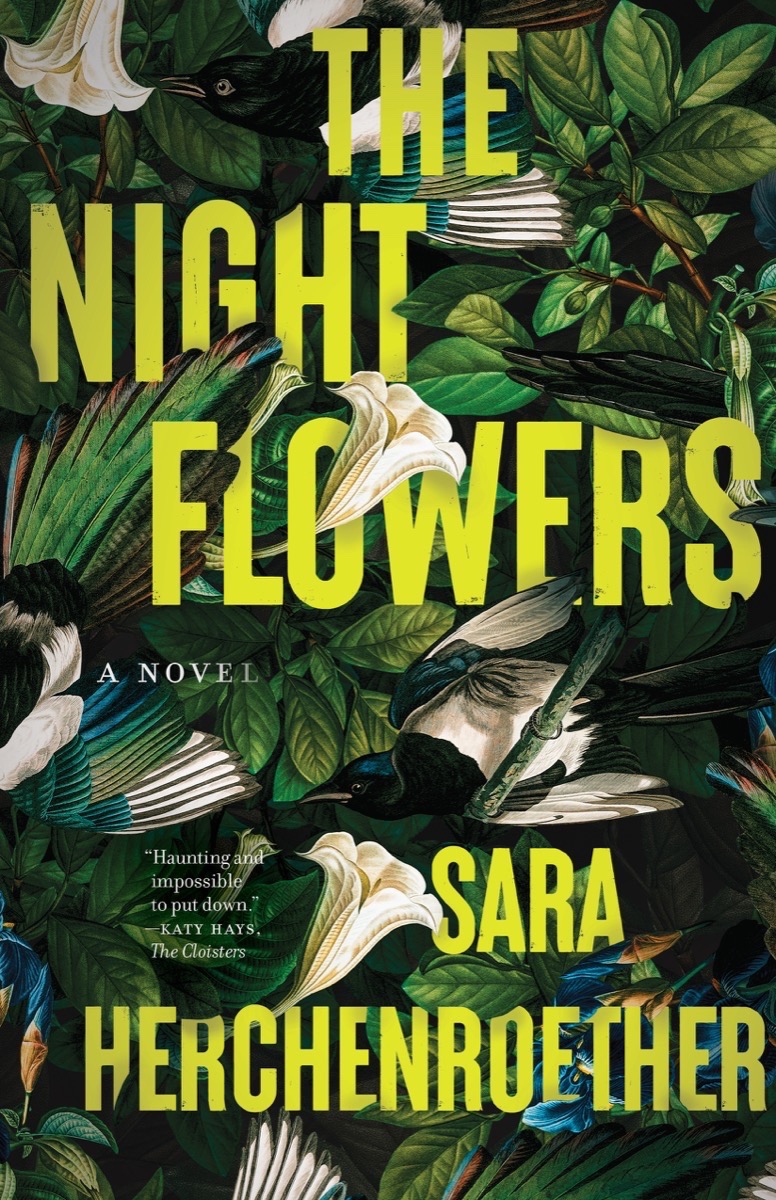 Laura deploys her passion for genealogy to help people searching for loved ones, and it also sustains her as she undergoes the necessary brutality of breast cancer treatment. Is there someone in your life who was the inspiration for Laura?
Laura deploys her passion for genealogy to help people searching for loved ones, and it also sustains her as she undergoes the necessary brutality of breast cancer treatment. Is there someone in your life who was the inspiration for Laura?
Laura comes from two real-world inspirations. I gave her a lot of what I went through as a cancer patient. Her work as a research librarian was inspired by Rebekah Heath, a research librarian who helped solve the Allenstown Four. I first learned about the murders of Marylse Honeychurch, Marie Vaughn, Sarah McWaters, and the unnamed middle daughter when they did not yet have names. Their killer was identified before these victims' names--even though investigators had been trying since the '80s.
Then, Rebekah Heath, working on her own in Connecticut, where I had lived for several years and where I had undergone treatment, figured out Marylse's name within a week of investigators on the other side of the country in California. I wanted to take that idea--twin investigations coming together to solve a case--and solve the murder in a different way.
As you mentioned, the language around cancer, where words such as "battle" or "warrior" are deployed, feels disingenuous to you. What language would you prefer to use instead?
Battle and warrior imply, if the person fights hard enough, they'll win. Cancer doesn't work that way. Sometimes there's no separating why one person dies and another doesn't. If you "fight hard" enough--whatever that means--and you die, is it your fault?
If readers take anything away from reading The Night Flowers, I hope they come away with a more nuanced way of looking at cancer. If the warrior badge works for you, great. But I also hope people see it's okay to not be okay.
Readers get to know and admire Jean through expertly crafted chapters showcasing police culture, homicide procedures, and the particular sarcastic humor one associates with favorite detective characters. What experience did you draw on to create these entertaining scenes?
The sarcasm comes from my family. We show love best through verbal jabs. My former students would say the sarcasm comes from Mrs. Herchenroether.
As for police procedure, I listen to a lot of police podcasts. I have a giant procedural textbook I haul out from its hiding place when I want to make sure I have something right. I have a real admiration for the people who make it their life's work to investigate violent crime. They too carry scars.
Laura and Jean could not be more different temperamentally and in their life experiences, yet they work well together. What is the magic ingredient in their successful partnership?
I wrote The Night Flowers before Hacks came out with Jean Smart and Hannah Einbinder. When it did, I thought, Okay, someone else has been thinking about this dynamic. And by that, I mean an older, world-weary woman mentoring a younger, haven't-quite-figured-things-out-yet 30-something-year-old. Or maybe I simply watched Return of the Jedi on VHS too many times as a kid. They're Obi-Wan and Luke, but women, with sarcasm and murder.
The third narrator, the deceased woman, brings an intriguing supernatural twist to the story. Was it difficult to write from her perspective?
Writing from Jane Doe's perspective was the most challenging. Jean and Laura's voice came far more naturally. It wasn't until I came upon the myth of Echo that Jane Doe began to reveal herself.
In the story, Echo, the nymph, falls out of favor with Juno. Sometimes she's described as tricking Juno, sometimes she's described as constantly talking, but either way, she goes and tells Juno that her husband has been messing around, and Juno condemns Echo to only repeat back what others say. Someone who is constantly talking, I thought, is someone who is seeking outside validation. If you get heard by the wrong type of person--a Narcissus--bad things can and will happen.
Were you a writer as a child?
I spent a lot of time by myself as a child. I was a voracious reader, and I had (have) an overactive imagination. So, yes. I wrote little stories, and in the sixth grade, wrote a novel, generously described as Jurassic Park fan fiction, if told from the point-of-view of the girl. I photocopied my handwritten pages, copied addresses from the copyright pages of books and shipped them off to New York, warning in my cover letter that I'd accept the first offer I received. Strangely, it never sold.
What is your advice for aspiring writers who struggle to find the time to write?
If you are a writer, you will find time to write because you'll have no other choice. A story will be crawling under your skin. The only way to expel the monster is to get it on paper. I wrote The Night Flowers during the pandemic, with four kids at home. I got up before them to write while my husband took the breakfast shift and found another hour in the afternoon while the youngest two napped. It can be done.
Readers will surely want to see Laura and Jean again. Will there be a sequel to The Night Flowers? What are you working on?
A few other early readers asked if The Night Flowers was the beginning of a series. If another story comes through for Laura and Jean, I'll go back to New Mexico. It's a place I fell in love with. My next book is set where I grew up, Massachusetts. It's a literary police procedural with two new detectives and plenty more sarcastic police banter. It has a book-within-a-book, and the book is an Irish myth retelling. It's about being able to return home, who gets to and who doesn't, and why. --Shahina Piyarali
Book Candy
Book Candy
Author Claire Kilroy chose her top 10 novels about motherhood for the Guardian.
---
The full auction catalog of bookseller and writer Larry McMurtry's partial personal estate has been released by Vogt Auction Galleries, Fine Books & Collections magazine reported.
---
"With their knowledge combined, two scholars are deciphering a long-lost Native language," Smithsonian magazine reported.
---
His gravestone reads "Don't Try." Mental Floss collected "7 facts about Charles Bukowski."
Great Reads
Rediscover: Ronald Steel
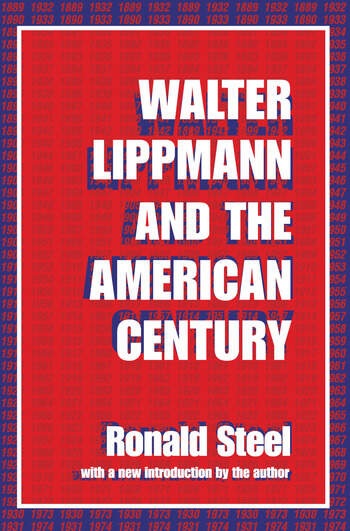 Historian Ronald Steel, "who derided America's Cold War foreign policies as a succession of misguided adventures and wrote a definitive biography of Walter Lippmann, the dean of 20th-century foreign policy realism," died May 7 at age 92, the New York Times reported. "In the high-stakes game of global chess, Mr. Steel infuriated presidents, secretaries of state and other national leaders with astringent yet sparkling essays," which filled seven books and hundreds of commentaries in the New Republic, the New York Times, and the New York Review of Books. He also taught at Yale, Princeton, the University of Southern California, and other universities.
Historian Ronald Steel, "who derided America's Cold War foreign policies as a succession of misguided adventures and wrote a definitive biography of Walter Lippmann, the dean of 20th-century foreign policy realism," died May 7 at age 92, the New York Times reported. "In the high-stakes game of global chess, Mr. Steel infuriated presidents, secretaries of state and other national leaders with astringent yet sparkling essays," which filled seven books and hundreds of commentaries in the New Republic, the New York Times, and the New York Review of Books. He also taught at Yale, Princeton, the University of Southern California, and other universities.
His best-known book, Walter Lippmann and the American Century (1980), was one of the most discussed political biographies of its time and a bestseller. It won the National Book Critics Circle Award for general nonfiction, Columbia University's Bancroft Prize, and the Los Angeles Times Book Prize for History; and was a finalist for the National Book Award and the 1981 Pulitzer Prize for biography. Its critical reception was divided, largely along political lines.
Steel insisted that Washington's strategy for dealing with Moscow--the postwar "containment doctrine" that defined American policy toward the Soviet Union for four decades--had been "wasteful and deluded, spawning costly wars in Korea and Vietnam and obsessions with national security that left Americans no more secure, prosperous or free than the rest of the world," the Times wrote.
In his first book, The End of the Alliance (1964), Steel argued that the North Atlantic Treaty Organization was already obsolete five years after its birth in 1949 and should be dissolved. In Pax Americana (1967), he warned of an obsession with "the Communist menace." The historian Henry Steele Commager called the book "the most persuasive critique of American foreign policy over the last 20 years."
Even after the Soviet Union collapsed in 1991, Steel contended in Temptations of a Superpower (1995) that American foreign policy remained incoherent because, he wrote, it was based on activism by presidents promoting their own political interests and causes, and because the U.S. still viewed itself as a global policeman, determined to guarantee stability around the world. Steel's last book, In Love with Night: The American Romance with Robert Kennedy (2000), attacked what he called myths about the senator that arose after his assassination in Los Angeles during the 1968 presidential primaries.
Steel kept an apartment in Washington for years, and rarely visited his hometown in Illinois. "I lived in New York and Paris and London, and in a dozen other places across the globe that for a time I called home," he told World Authors. "All those places shaped me in one way or another. But somewhere along the way I also stopped trying to escape from the small town. Confinement, I've come to think, lies more in the head than in the place." Walter Lippmann and the American Century is available from Routledge.


